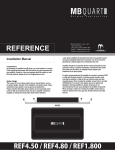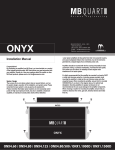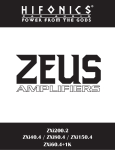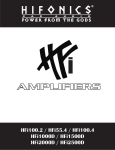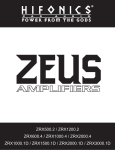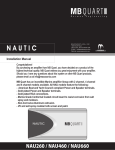Download MB QUART Q4.80 Installation manual
Transcript
Q Lower power amplifiers will clip earlier than their more powerful cousins, and cause loudspeaker failure when overdriven, due to the harmonics generated by a clipped signal, thus overheating voice coils. Installation Manual Amplifiers should be mounted with the fins running horizontally for best convection cooling, to minimize overheating. Purchase the best quality RCA cables you can afford, for reliability and less engine noise interference in the audio system. Congratulations! By purchasing an amplifier from MB Quart, you have decided on a product of the highest technical quality. MB Quart wishes you great enjoyment with your amplifier. Should you have any questions about this system or other MB Quart products, please email us at [email protected] It is highly recommended that the amplifier be mounted to a board of MDF or other solid structure using the 4 mounting screws provided. Avoid mounting the amplifier to metal as this can introduce noise and other unwanted issues. When mounting the amplifier, ensure that it is mounted HORIZONTALLY, as shown in the diagram above, for optimal heat dissipation. Mounting amplifiers to speaker enclosures is not recommended as this can cause damage to the amplifier components. When choosing a location for mounting the amplifier, ensure that you check for clearance from wires, gas tank, electrical devices and brake lines etc. System Design The success of any car stereo system relies on several factors, such as the system design, execution of the installation, and system setup. Please remember that any system is only as good as its weakest link. Please remember that higher power systems are not necessarily useful purely for high sound pressure levels, but also to establish a headroom capability, to reproduce musical peaks cleanly without distortion. WOOD CLIP INDICATOR AMBERSOFT CLIP REDHARD CLIP GREENPRE CLIP CLIP INDICATOR GREENPRE CLIP LEVEL 9V BASS BOOST 0dB 12dB MULTIPLIER FREQUENCY 9V 0.2V BASS BOOST 0dB X1 12dB BASS FREQUENCY 30Hz X15 AMBERSOFT CLIP REDHARD CLIP LEVEL 0.2V 80Hz HIGH PASS FILTER SLOPE 6dB 12dB 15Hz 1KHz CHANNELS 1&2 CHANNELS 3&4 HIGH PASS LOW PASS (x1) 20Hz (x15) 300Hz 300Hz 4.5KHz CROSSOVER DUPE (3&4) HP-FULL PROTECT POWER 40Hz 4.5KHz CROSSOVER LP-BP LP-BP HP-FULL MONO STEREO INPUT MODE 4CH 2CH Q4.80 / Q4.150 / Q1.1500D Index WARRANTY 1 General Instructions 2 3 Features Q4.80 / Q4.150 4-Channel Amplifiers 4-5 Q1.1500D Mono Amplifier 6-7 Settings for Best Performance 8 Trouble Shooting 9 Technical Data 10 Check out our videos of new products, events and technical tutorials at www.youtube.com/maxxsonicsusainc WARRANTY 1 1 General Instructions General: Run the wiring so that RCA cables are at least 18“ away from power and speaker cables. Keep RCA cables away from electrical devices in the vehicle that can cause electrical noise, such as electric fuel pumps, emission control modules and other on-board electronic modules. Power and ground connections:(See table below) Use a sufficient gauge power cable and ground cable using the chart below as reference to what size wire you require. Q series amplifiers require at least 4 gauge power wire. In a multi amplifier system, add the total value of the manufacture recommended fusing to get your total system amperage. Some applications may require multiple runs of power wire to meet the system requirements. In multi amplifier systems it is advisable to mount a large enough fuse right at the battery, and run one or multiple +12 volt power cables to a fused distribution block near the amplifiers. It is then a simple matter to connect the +12 volt terminal of each amplifier to the distribution block. During this process, please ensure that the main power fuse is removed to avoid shorting the electrical system. The main fuse must be within 12” of the vehicles battery. Ground each amplifier with as short a ground lead as possible directly to the vehicle chassis using at least 4 gauge wire or equivalent to the size of the amplifiers’ power wire. Use a ground distribution block, if you wish, but it is extremely important to keep the main ground lead from this distribution block to the chassis as short as possible , not more than 12“. The ground connection integrity to the chassis is very important, and the best way to achieve a good, solid electrical and mechanical contact is to use a large round crimp lug, crimped and soldered to the ground cable. The next step is to scrape the paint off the vehicle chassis , slightly larger than the ground lug, at the connection point. Drill a clearance hole in the chassis, the same size as the lug hole, and use a bolt, spring washer and nut to securely fasten the ground lug. Use petroleum jelly to coat the bolt/lug connection, to prevent oxidization with time. TIP: Use the same approach when installing head units, equalizers or any audio equipment for that matter - run short individual grounds from each piece directly to the vehicle chassis, to minimize ground loops and system noise. All power, ground and speaker connections should be crimped and soldered for reliability. Make sure that none of the cable insulation can chafe against exposed metal in the vehicle, causing short circuits to the chassis. Safe connection sequence: After all cables are run, connect speaker wires to the speakers and amplifiers, then run and plug in RCA cables. Next, connect all power, ground, and remote turn on leads. Now connect all +12 volt cables to the amplifier/s and distribution blocks and fuse holders. Finally, connect the main +12 volt cable to the battery, with the main fuse removed, and we are almost ready to power up the system. Power up the system: The following procedure may seem like overkill, but there is nothing more frustrating when turning on a system for the first time, and it does not work properly immediately. First, make sure the head unit is off, and turn all level controls to minimum (counterclockwise), including the head unit volume control. Set all equalizers to 0 dB (no boost), and all crossover frequency controls at approximate frequencies, as recommended by the loudspeaker manufacturer. Set all input selector and crossover switches as required for the application. Remove all amplifier fuses, and insert the main fuse at the battery. If the fuse does not blow, you can insert the fuse in one of the amplifiers, and we are ready to turn on the system. Turn the head unit on, insert a CD, or select a radio station, and increase the head unit volume control. If the system sounds fine, turn off the head unit, and install fuses in the remaining amplifiers, one by one, till the complete system is powered up and functioning properly. WIRE LENGTH SYSTEM AMPERAGE 10-13 ft. 13-16 ft. 16-19 ft. 19-22 ft. 22-28 ft. 35-50 8 6 4 4 4 4 50-65 6 4 4 4 4 2 68-85 4 4 2 2 2 0 85-105 4 2 2 2 2 0 105-125 4 2 0 0 0 0 125-150 2 0 0 0 0 0 WIRE GAUGE 2 7-10 ft. Q4.80 / Q4.150 / Q1.1500D Features Q4.80 Q4.150 CLIP INDICATOR CLIP INDICATOR AMBERSOFT CLIP REDHARD CLIP GREENPRE CLIP LEVEL 9V LEVEL 0.2V 9V BASS BOOST 0dB AMBERSOFT CLIP REDHARD CLIP GREENPRE CLIP 0dB 12dB MULTIPLIER FREQUENCY 0.2V BASS BOOST 12dB BASS FREQUENCY 30Hz X15 X1 80Hz HIGH PASS FILTER SLOPE 6dB 12dB 15Hz 1KHz CHANNELS 1&2 CHANNELS 3&4 HIGH PASS LOW PASS (x1) 20Hz (x15) 300Hz 300Hz 4.5KHz 40Hz DUPE (3&4) HP-FULL 4.5KHz CROSSOVER CROSSOVER LP-BP LP-BP HP-FULL MONO STEREO INPUT MODE PROTECT POWER 4CH 2CH Q1.1500D GREEN-PRE CLIP AMBER-SOFT CLIP RED-HARD CLIP PROTECT POWER CLIP INDICATOR CONTROL LEVEL Q-LINK 9V 0.2V PHASE SHIFT 0 180 INPUT SLAVE OUTPUT MASTER SUBSONIC 15Hz 35Hz PARAMETRIC BASS EQ BASS BOOST 0dB 12dB BANDWIDTH LOW PASS 35Hz 30Hz WIDE 200Hz BASS FREQUENCY NARROW 80Hz - CLIP INDICATOR: - GREEN = Pre-Clip - AMBER = Soft Clip - RED = Hard Clip - LEVEL: Variable sensitivity from 0.2V to 9V - BASS BOOST: Variable bass boost from 0dB to 12dB - BASS FREQUENCY: Frequency to be boosted, variable from 30Hz to 80Hz - HIGH PASS: - CH3&4: Variable HIGH PASS filter from 15Hz to 1KHz - CH1&2: Variable HIGH PASS filter from 20Hz to 300Hz - MULTIPLIER FREQUENCY: Available for CH1&2 only and variable selector for x15 or x1 the selected HIGH PASS value - FILTER SLOPE: Roll off for HIGH PASS on CH1&2, selectable at 6dB or 12dB - CROSSOVER: - CH3&4: - LP-BP MONO: Selected when bridging CH3&4 on subwoofers - LP-BP STEREO: Selected when running CH3&4 in stereo on subwoofers - HP-FULL: Selected when running CH3&4 in stereo for full range speakers - CH1&2: - DUPE (3&4): Bypasses all variables on CH1&2 and duplicates settings from CH3&4 - HP-FULL: Selected when running CH3&4 in stereo for full range speakers - PROTECT: Red LED which indicates PROTECTION - POWER: Green LED which indicates the amplifier is “ON” - INPUT MODE: - 4CH: Selected when two sets of RCA’s are being connected to CH1&2 and CH3&4 - 2CH: Selected when only one set of RCA’s are being connected to CH1&2. The amp will automatically provide signal to CH3&4 but there will be no FADE from front to rear on your headunit controls. - PROTECT: Red LED which indicates PROTECTION - POWER: Green LED which indicates the amplifier is “ON” - CLIP INDICATOR: - GREEN = Pre-Clip - AMBER = Soft Clip - RED = Hard Clip - LEVEL: Variable sensitivity from 0.2V to 9V - Q-LINK: Allows linking of two Q1.1500D amplifiers to produce 3KW rms @ 2-Ohms - INPUT SLAVE: Selected when amplifier is being linked as SLAVE and receiving signal from the MASTER amplifier. When in INPUT SLAVE position all other adjustments are bypassed - OUTPUT MASTER: Selected when amplifier is being linked as MASTER and providing signal to the SLAVE amplifier. This amplifiers’ adjustments now control both amps - PHASE SHIFT: Adjustable time alignment from 0 to 180 degrees - SUBSONIC: Variable from 15Hz to 35Hz - LOW PASS: Variable from 35Hz to 200Hz - BASS BOOST: Variable bass boost from 0dB to 12dB - BASS FREQUENCY: Frequency to be boosted, variable from 30Hz to 80Hz - BANDWIDTH: Range of frequencies to be boosted - Variable from WIDE to NARROW. WIDE includes less frequencies to be boosted while NARROW includes more frequencies to be boosted above and below the selected frequency PRE-AMP X-OVER 3 Q4.80 / Q4.150 4-Channel Amplifiers 4 Channel Full Range Stereo: Interconnect cable checklist: - Connect the four inputs of the amplifier to a Radio/CD with quality RCA cables. Switch setting checklist: - 1/2CH X-OVER: HP-FULL - MULTIPLIER FREQUENCY: X1 - FILTER SLOPE: 12dB - 3/4CH X-OVER: HP-FULL INPUT MODE: 4CH since 2 sets of RCA’s are connected. Control checklist: - Refer to the section “Settings for Best Performance” Minimum final loudspeaker impedances: - 2 ohm per channel. INPUT AMBERSOFT CLIP REDHARD CLIP CLIP INDICATOR AMBERSOFT CLIP REDHARD CLIP GREENPRE CLIP LEVEL LEVEL CH1 CH2 SPEAKER OUTPUT BRIDGED BRIDGED + Ch2 + Ch3 + Ch4 - CH3 CH4 CLIP INDICATOR GREENPRE CLIP 9V 0.2V BASS BOOST 0dB 12dB 0.2V 0dB 12dB BASS FREQUENCY 30Hz X15 X1 + Ch1 MULTIPLIER FREQUENCY 9V BASS BOOST 80Hz HIGH PASS 1KHz LOW PASS (x1) 20Hz (x15) 300Hz 300Hz 4.5KHz CROSSOVER DUPE (3&4) HP-FULL PROTECT OUT POWER 40Hz 4.5KHz CROSSOVER LP-BP LP-BP HP-FULL MONO STEREO INPUT MODE 4CH 2CH 2 or 3 Channel System: Here we show how to use the 4 channel amplifiers as a 3 channel unit by taking advantage of the mono bridging capability of all MB Quart amplifiers. In order to create a 2 channel system, simply follow the example to also mono bridge channel pair 1/2. Interconnect cable checklist: - Connect the inputs of channel pair 1/2 to a suitable stereo source, e.g. a head unit with good quality RCA cables. - A MONO signal source is required to bridge channel pair 3/4, such as would be available from the mono sub bass output of an active crossover, whether standalone, or built into a head unit or equalizer. Important: Do not be tempted to connect the hot, or positive outputs, from any source together to obtain a mono signal, as this could very well damage the output stage of that source. - It is necessary to feed the SAME signal to both left and right inputs via a Y-adapter RCA cable. Switch setting checklist: - 1/2CH X-OVER: HP-FULL - MULTIPLIER FREQUENCY: X1 - FILTER SLOPE: 12dB - 3/4CH X-OVER: LP-BP MONO INPUT MODE: 4CH, Stereo Left and Right to CH1&2 and MONO to CH3&4 Control checklist: - Refer to the section “Settings for Best Performance” Minimum final loudspeaker impedances: - 2 ohm per channel in stereo mode. - 4 ohm mono bridged. INPUT AMBERSOFT CLIP REDHARD CLIP GREENPRE CLIP CLIP INDICATOR GREENPRE CLIP LEVEL AMBERSOFT CLIP REDHARD CLIP LEVEL CH1 CH2 9V 0.2V BASS BOOST 0dB 12dB 0.2V 0dB 12dB BASS FREQUENCY 30Hz X15 X1 + Ch1 MULTIPLIER FREQUENCY 9V BASS BOOST SPEAKER OUTPUT BRIDGED BRIDGED + Ch2 + Ch3 + Ch4 - CLIP INDICATOR STEREO LINE INPUT - Connect the mono speaker positive terminal to the Ch3 +, and its negative terminal to Ch4 - as shown. CH3 CH4 MONO LINE INPUT REM BATT+12V 15Hz CHANNELS 3&4 HIGH PASS POWER INPUT 12dB CHANNELS 1&2 GND 6dB FUSE FILTER SLOPE 80Hz HIGH PASS 300Hz 4.5KHz CROSSOVER DUPE (3&4) HP-FULL PROTECT OUT POWER 40Hz 4.5KHz CROSSOVER LP-BP LP-BP HP-FULL MONO STEREO INPUT MODE 4CH 2CH REM BATT+12V 1KHz LOW PASS (x1) 20Hz (x15) 300Hz 4 15Hz CHANNELS 3&4 POWER INPUT 12dB HIGH PASS GND 6dB CHANNELS 1&2 FUSE FILTER SLOPE Q4.80 / Q4.150 4-Channel Amplifiers 4 Channel Full Range Stereo With Mono Amp For Subwoofers: Interconnect cable checklist: - Connect the four inputs of the amplifier to a Radio/CD with quality RCA cables. Switch setting checklist: - 1/2CH X-OVER: HP-FULL - MULTIPLIER FREQUENCY: X1 - FILTER SLOPE: 12dB - 3/4CH X-OVER: HP-FULL -RCA’s from OUTPUT on 4CH amp to INPUTS on MONO amp. Control checklist: - Refer to the section “Settings for Best Performance” Minimum final loudspeaker impedances: - 4CH Amp: 2 ohm per channel. - MONO Amp: 1 Ohm INPUT MODE: 4CH since 2 sets of RCA’s are connected. CLIP INDICATOR AMBERSOFT CLIP REDHARD CLIP INPUT GREENPRE CLIP LEVEL AMBERSOFT CLIP REDHARD CLIP LEVEL CH1 CH2 SPEAKER OUTPUT BRIDGED BRIDGED + Ch2 + Ch3 + Ch4 - CH3 CH4 CLIP INDICATOR GREENPRE CLIP 9V 0.2V 9V BASS BOOST 0dB 0.2V BASS BOOST 0dB 12dB 12dB BASS FREQUENCY 30Hz X15 X1 + Ch1 MULTIPLIER FREQUENCY 80Hz HIGH PASS 15Hz 1KHz CHANNELS 3&4 HIGH PASS LOW PASS 300Hz 4.5KHz 40Hz DUPE (3&4) 4.5KHz CROSSOVER CROSSOVER POWER INPUT (x1) 20Hz (x15) 300Hz LP-BP LP-BP HP-FULL MONO STEREO HP-FULL INPUT MODE PROTECT OUT POWER 4CH 2CH REM BATT+12V 12dB CHANNELS 1&2 GND 6dB FUSE FILTER SLOPE FULL RANGE RCA PASS THROUGH MONO SUBWOOFER BALANCED INPUT 0.2V PHASE SHIFT 0 180 INPUT SLAVE + Q-LINK 9V + CLIP INDICATOR CONTROL LEVEL SPEAKER OUTPUT OUTPUT INPUT L R GREEN-PRE CLIP AMBER-SOFT CLIP RED-HARD CLIP PROTECT POWER OUTPUT MASTER SUBSONIC 15Hz 35Hz REMOTE BANDWIDTH 35Hz 200Hz BASS FREQUENCY GND CHASSIS GROUND REMOTE TURN-ON TO BATTERY + 12 Volts VIA FUSE MAXX SLAVE INPUT MASTER OUTPUT MBQR-2 30Hz WIDE NARROW PRE-AMP X-OVER 80Hz FUSE MIN 12dB BATT+12V REM 0dB LOW PASS POWER INPUT PARAMETRIC BASS EQ BASS BOOST 5 Q1.1500D Mono Amplifiers Interconnect cable checklist: Connect the inputs to a suitable source, e.g. a head unit with good quality RCA cables. Use at least #12 gauge speaker wiring. The amps have dual speaker terminals, simplifying the hookup of multiple speakers. These amps are mono, 1 channel, amplifiers which have multiple positive and negative connections for ease of wiring. The 2 positives are the same internally and the 2 negatives are the same internally. Control checklist: Refer to the section “Settings for Best Performance” Minimum final loudspeaker impedance: 1-Ohm. MONO SUBWOOFER BALANCED INPUT 0.2V PHASE SHIFT 0 180 INPUT SLAVE + Q-LINK 9V - CLIP INDICATOR CONTROL LEVEL + POWER SPEAKER OUTPUT OUTPUT INPUT L R DESIGNATED MONO OUTPUT FROM HEAD UNIT GREEN-PRE CLIP AMBER-SOFT CLIP RED-HARD CLIP PROTECT OUTPUT MASTER SUBSONIC 15Hz 35Hz 0dB REMOTE 200Hz BASS FREQUENCY MAXX SLAVE INPUT MASTER OUTPUT MBQR-2 6 BANDWIDTH 35Hz 30Hz WIDE NARROW PRE-AMP X-OVER 80Hz FUSE MIN 12dB GND LOW PASS BATT+12V REM BASS BOOST POWER INPUT PARAMETRIC BASS EQ CHASSIS GROUND REMOTE TURN-ON TO BATTERY + 12 Volts VIA FUSE Q1.1500D Linking Mono Amplifiers DUAL AMP INSTALLATION PROCEDURE: 1. Connect the amp LINE INPUTS to the Radio/CD player full range or mono line out puts with good quality RCA interconnect cables. 2. Plug in the MBQR-2 remote level module into the amp REMOTE INPUT jack on the Master amp. This will allow the Master amp to control both Master and Slave amps with just one Bass Remote. 3. Connect an RCA jumper cable from the Master amp MASTER OUTPUT to the Slave amp SLAVE INPUT. Note: This will “link” the amps so that the Master amp crossover switches will control both the Master and Slave amps. The Slave amp crossover switches will be bypassed. 4. Route two 2 gauge power cables directly to the vehicle battery with an in-line fuse. 5. Connect two 2 gauge ground cables directly to the chassis with in 36” of the amp. - Be sure to remove any paint or primer from the ground point. - Use a nut, bolt and lock washer to secure the ground cable to the chassis ground. 6. Make sure the Master amp MASTER/SLAVE switch is in the OUTPUT MASTER position. Make sure the Slave amp MASTER/SLAVE switch is in the INPUT SLAVE position. 7. Connect the subwoofer(s) in accordance to the diagrams below. 8. Connect a 12 gauge jumper from Master amp speaker - to Slave amp speaker - as shown below. The Linked pair of Q1.1500D’s are stable to 2 Ohms and will produce 3000wrms. Do not present anything under 2 Ohms to the linked pair or the amplifiers will be damaged. Linking two amps for single or dual subwoofer application Amplifiers are stable to 2-Ohms linked BALANCED INPUT INPUT SLAVE 0.2V PHASE SHIFT 0 + Q-LINK 9V + CLIP INDICATOR CONTROL LEVEL - - (MASTER) SPEAKER OUTPUT OUTPUT INPUT L R DESIGNATED MONO OUTPUT FROM HEAD UNIT GREEN-PRE CLIP AMBER-SOFT CLIP RED-HARD CLIP PROTECT POWER OUTPUT MASTER SUBSONIC 180 15Hz 35Hz REMOTE 200Hz BASS FREQUENCY GND MAXX FUSE 80Hz NARROW PRE-AMP X-OVER CLIP INDICATOR CONTROL BALANCED INPUT LEVEL 0.2V PHASE SHIFT 0 180 INPUT SLAVE + Q-LINK 9V (SLAVE) - OUTPUT INPUT L R OUTPUT MASTER SUBSONIC 15Hz 35Hz 0dB 12dB REMOTE BANDWIDTH LOW PASS 35Hz SLAVE INPUT MASTER OUTPUT 30Hz WIDE 200Hz BASS FREQUENCY NARROW PRE-AMP X-OVER 80Hz GND BASS BOOST POWER INPUT PARAMETRIC BASS EQ BATT+12V REM MASTER OUTPUT TO SLAVE INPUT RCA JUMPER CABLE GREEN-PRE CLIP AMBER-SOFT CLIP RED-HARD CLIP PROTECT POWER MONO SUBWOOFER + 30Hz WIDE SPEAKER OUTPUT SLAVE INPUT MASTER OUTPUT MBQR-2 FUSE MIN 35Hz 12dB BANDWIDTH POWER INPUT 0dB LOW PASS BATT+12V REM BASS BOOST 12 GAUGE JUMPER WIRE PARAMETRIC BASS EQ 7 Settings for Best Performance Q4.80 / Q4.150 General: At this point you are ready to get more specific on the settings for your amplifier. High Pass: -When in HP-FULL operation, this setting acts as a low frequency cut off for your system reproduction. The point that you set it at cuts off any frequencies from reproduction beyond this point. The 12 o’clock position is a great starting point. EXAMPLE: If you adjust the High Pass to 100Hz, the amplifier will not play frequencies below 100Hz but will play frequencies from 100Hz to the highest frequency the amplifier is capable of reproducing. -When in LP-BP operation, this setting acts as a low frequency cut off for your system reproduction aka Subsonic Filter. The point that you set it at cuts off any frequencies from reproduction beyond this point. The 12 o’clock position is a great starting point. EXAMPLE: If you adjust the High Pass to 60Hz, the amplifier will not play frequencies below 60Hz but will play frequencies from 60Hz to the chosen Low Pass frequency Filter Slope: Selectable roll off for High Pass setting which is variable at 6dB for a steep cut, or 12dB for a smooth rolloff. Bass Boost: This setting is variable from 0-12dB. This feature provides impact to your bass, but if not adjusted correctly, it can be over used and cause damage to your speakers and amplifiers. It is best to slowly turn this setting clockwise until the desired punch is felt. It is not recommended to exceed the 12 o’clock position unless listening at a low volume or a low recording quality as this can result in high distortion and possibly clipping. Bass Frequency: Selects the frequency to amplify with the Bass Boost. Variable from 30Hz-80Hz. 11o’clock is 45Hz for reference. Low Pass: The Low Pass control acts as a ceiling and doesn’t allow frequencies to the right of the desired setting to be reproduced. Turning the potentiometer all the way to the right is a great starting point. EXAMPLE: If you adjust the Low Pass to 120Hz, the amplifier will not play frequencies above 120Hz but will play frequencies from 120Hz to the chosen Hi Pass or Subsonic frequency. Level Control Setup: Ensure that the Level is turned completely to the left prior to turning the system on. Next you should insert a CD or cassette that you are familiar with to use as a reference, and turn the head unit volume control to about 80% of its full setting. The system sound level will of course be very low, and the following procedures will help you to match the amplifier input sensitivities properly to the head unit output signal level. It is important to match the amplifier LEVEL input sensitivity to the Radio/CD output sensitivity. This can be located in the Radio/CD manual. If the Radio/CD output sensitivity is 2 volts, then adjust the amplifier LEVEL input to 2 volts. If you are not sure what the Radio output sensitivity is, follow these general guide lines: Turn the level control up slowly, till you hear distortion, then back off a few degrees on the control. If at any point your amplifier goes into protection, you will need to turn the Level to the left a bit and then try again. If you reach a point where the output does not increase, stop turning the Level control to the right as the amplifier/speaker combo has reached its maxx output in this application. Q1.1500D General: At this point you are ready to get more specific on the settings for your amplifier. Phase: Time alignment, typically recommended at 0 degrees unless using multiple amps and subs in both the front and rear of the vehicle. The Phase can be adjusted to give the perception of bass reaching the listener at the same time regardless of location. Subsonic: This setting acts as a low frequency cut off for your system bass reproduction. The point that you set it at cuts off any frequencies from reproduction beyond this point. The 12 o’clock position is a great starting point. EXAMPLE: If you adjust the Subsonic to 25Hz, the amplifier will not play frequencies below 25Hz but will play frequencies from 25Hz to the chosen Low Pass frequency. Bass Frequency: This setting is used for selecting the frequency you want to focus your enhancement on. Suggested enhancement is from 35-45Hz, but you should be careful not to set enhancement below the F3 or -3dB point of your sub/enclosure combo. Bandwidth: This setting controls the amount of frequencies included in the Bass Boost. The bandwidth varies from narrow to wide in a pyramid style boost with the selected Bass Frequency value being the center. Bass Boost: This setting adjusts the amount of boost on the selected Bass Frequency and Bandwidth. This setting is variable from 0-12dB. This feature provides impact to your bass, but if not adjusted correctly, it can be over used and cause damage to your subwoofers and amplifiers. It is best to slowly turn this setting clockwise until the desired punch is felt. It is not recommended to exceed the 12 o’clock position unless listening at a low volume or a low recording quality as this can result in high distortion and possibly clipping. Low Pass: The Low Pass control acts as a ceiling and doesn’t allow frequencies to the right of the desired setting to be reproduced. The 12 o’clock position is a great starting point. EXAMPLE: If you adjust the Low Pass to 80Hz, the amplifier will not play frequencies above 80Hz but will play frequencies from 80Hz to the chosen Subsonic frequency. Level Control Setup: Ensure that the Level is turned completely to the left prior to turning the system on. Next you should insert a CD or cassette that you are familiar with to use as a reference, and turn the head unit volume control to about 80% of its full setting. The system sound level will of course be very low, and the following procedures will help you to match the amplifier input sensitivities properly to the head unit output signal level. It is important to match the amplifier LEVEL input sensitivity to the Radio/CD output sensitivity. This can be located in the Radio/CD manual. If the Radio/CD output sensitivity is 2 volts, then adjust the amplifier LEVEL input to 2 volts. 8 If you are not sure what the Radio output sensitivity is, follow these general guide lines: Turn the level control up slowly, till you hear distortion, then back off a few degrees on the control. If at any point your amplifier goes into protection, you will need to turn the Level to the left a bit and then try again. If you reach a point where the output does not increase, stop turning the Level control to the right as the amplifier/subwoofer combo has reached its maxx output in this application. Trouble Shooting The key to finding the problem in a misbehaving sound system is to isolate parts of that system in a logical fashion to track down the fault. Description of the Diagnostic system built into all MB Quart amplifiers The diagnostic system will shut down the amplifier, until reset by turning the head unit off, and back on. This state of affairs will be indicated by the front panel PROTECT LED lighting up under the following conditions: A short circuit on the loudspeaker leads, an internal amplifier fault that causes a DC offset on the loudspeaker output, and a voltage drop or surge to an unsafe level for the amplifier. Should the amplifier go into diagnostic mode, simply disconnect all RCA and speaker leads, while keeping +12 volt, power ground and remote leads connected. 1. Now turn the amplifier back on, and if the diagnostic LED lights, the amplifier has an internal fault. 2. If not, plug the RCA cables back, and reset the amplifier. If it goes into diagnostic now, the fault lies in the input, either with bad cables or source unit. 3. If the amplifier seems fine with RCA cables plugged in, connect the speakers, one at a time, and if one of the speakers or its wiring is faulty, it will activate the diagnostic system. Amplifier heatsink overheating The amplifiers will shut down when the heatsink temperature reaches 80 degrees centigrade, and turn back on once the unit has cooled down below that point. Causes of overheating: 1 - Inadequate cooling - relocate or remount to provide better natural airflow over the fins. 2 - Driving high power levels into low impedances - back off on the volume control, and/or make sure you are not loading the amplifier with less than the recommended loudspeaker impedance. Low output power 1 - Check that level controls have been set up properly. 2 - Make sure that the battery voltage, as measured at the amplifier’s +12 volt and ground terminals, is 11 volts or more. 3 - Check all +12 volt and ground connections. Fuses blowing 1 - The use of loudspeaker impedances below the recommended minimums will draw more current - check. 2 - A short on the main +12 volt cable from the battery to the vehicle chassis will cause the main fuse to blow. 3 - If an amplifier fuse blows continually, with only +12 volt, ground and remote leads connected, the amplifier may be faulty. System does not turn on 1 - Check all fuses. 2 - Check all connections. 3 - Measure the +12 volt and remote turn on voltages at the amplifier terminals. If these are non existent or low, take voltage measurements at fuse holders, distribution blocks, the head unit’s +12 volt and remote leads to localize the problem. Noise problems System noise can be divided into two categories, hiss, and electrical interference. Hiss, or white noise 1 - High levels of white noise usually occurs when amplifier level controls are turned up too high - readjust according to the procedures in section ”Setting up systems after installation for best performance” 2 - Another major problem that can cause excessive hiss, is a noisy head unit - unplug the amplifier input RCA cables, and if the hiss level reduces, the source unit is at fault. Electrical interference The inside of an automobile is a very hostile electrical environment. The multitude of electrical systems, such as the ignition system, alternator, fuel pumps, air conditioners, to mention just a few, create radiated electrical fields, as well as noise on the +12 volt supply and ground. Remember to isolate the problem - first unplug amplifier input RCA cables, if the noise is still present, check the speaker leads, if not, plug the RCA’s back, and investigate the source driving the amplifier, one component at a time. A ticking or whine that changes with engine RPM: 1 - This problem could be caused by radiation pickup of RCA cables too near to a fuel pump or a distributor, for instance, - relocate cables. 2 - Check that the head unit ground is connected straight to the vehicle chassis, and does not use factory wiring for ground. 3 - Try to supply the head unit with a clean +12 volt supply directly from the battery +, instead of using a supply from the in dash wiring/fusebox. A constant whine: This type of noise can be more difficult to pinpoint, but is usually caused by some kind of instability, causing oscillations in the system. 1 - Check all connections, especially for good grounds. 2 - Make sure that no speaker leads are shorting to exposed metal on the vehicle chassis. 3 -RCA cables are notorious for their problematic nature, so check that these are good, in particular the shield connections. 9 70Amps x 2 10 OEM Integration Accessories MX-1 Premium High To Low Level Converter * Converts High Level OEM speaker wires to Ultra Clean RCA Low Level Outputs * High Level Inputs: Accepts all types of High level Inputs including floating ground and high voltages up to 30 volts. * Audio Signal Sense / Hardwire Turn-On: Audio sense detects music signals from the OEM wires and activates the MX-1. As an option, the module also offers a remote turn-on wire. * Parametric Bass EQ: Features Bass Boost, adjustable Band Width (wide & narrow), Low Pass and Subsonic Filter. * Clipping Indicators: Visually indicates audio signals Pre-Clip, Soft Clip and Hard Clip * Balanced Line Output: Ultra clean DIN variable high voltage output for driving mono amps. * Remote Output: Driver circuit to turn on amplifier when module activates. * Bass Remote: Features for subwoofer Level control with builtin clipping indicators. * Input & Output Level Control: Allows for gain matching both radio and amplifier audio signals. MX-3 Bass Controller * Parametric Bass EQ: Provides a wide array of subwoofer output signal shaping controls to enhance bass response and sound quality including Bass Boost, adjustable Bandwidth (wide and narrow), Low Pass and Subsonic Filter. * Accepts a wide range of incoming music signal levels while accommodating all types of head units and signal processors and controlling the output level to the amp to maximize a signal strength up to 9 volts. * Clipping Indicators: Visual clipping indicators provide indication of damaging clipped signals to help protect the subwoofer(s) and amplifier. Includes pre-clip, soft-clip and full-clip indications. * Music Shaping: Shapes the music signal to achieve deep bass notes as low as 15Hz. * Bass Remote: Included bas Remote features built-in clipping indicators allows direct bass control from in-dask or under-dash. MX-2 Deluxe High To Low Level Converter MX-4 Add A Sub High To Low Level Converter * Converts High Level OEM speaker wires to Ultra Clean RCA Low Level Outputs * High Level Inputs: Accepts all types of High level Inputs including floating ground and high voltages up to 30 volts. * Audio Signal Sense / Hardwire Turn-On: Audio sense detects music signals from the OEM wires and activates the MX-2. As an option, the module also offers a remote turn-on wire. * Remote Output: Driver circuit to turn on amplifier when module activates. * Converts High Level OEM speaker wires to Ultra Clean RCA Low Level Outputs * High Level Inputs: Accepts all types of High level Inputs including floating ground and high voltages up to 30 volts. * Audio Signal Sense / Hardwire Turn-On: Audio sense detects music signals from the OEM wires and activates the MX-4. As an option, the module also offers a remote turn-on wire. * Remote Output: Driver circuit to turn on amplifier when module activates. 11 Check out our videos of new products, events and technical tutorials at www.youtube.com/maxxsonicsusainc PART#S510 Q4.80 / Q4.150 / Q1.1500D













